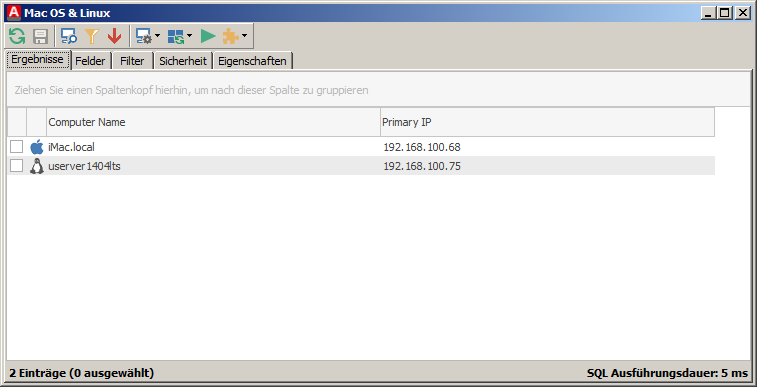XML Importer
The XML Importer is used to inventory Linux and MacOS Clients. It can be installed during the installation of the Agentless Scanner or at a later time on the ACMP Server alone. To inventory the Clients, a local Python script is executed on the Linux and Mac Clients, which collects all necessary information from the Client and saves it in an XML file. Each Client generates its own XML file with inventory data. This XML file is then stored on a network share. This Python script can be distributed to the clients and executed using the Client Command “Linux and MacOS Inventory” under “Advanced Inventory”. The XML Importer service periodically searches the configured network shares, reads the inventory information from the XML files, and writes it to the ACMP database.
In the query management, the Linux and macOS Clients are marked with a Tux or an apple icon.

Display Linux and Mac OS Clients

Agentless Scanner: XML Importer
Please note that neither NT notation (with \) nor UPN notation (with @) can be used for the user name for logging on to the network share. If a local user is to be used, the name of the machine must be entered in the Domain field. In addition, the password must not contain an @ sign.
Please refer to the system requirements for the supported distributions. The following requirements must also be met:
- Sufficient rights to execute commands with “sudo”
- SSH service must be installed, started, and accessible
In addition, the following points must be observed when inventorying Linux Clients:
- Only software that has been installed via the package managers “dpkg” or “rpm” is inventoried
- The following programs must be installed:
- “hdparm” for reading hard drives and drive information
- “dmidecode” for reading BIOS information
- “lsb_release” for reading distribution information
- “aptitude” for reading software information (only with the dpkg package manager)
- “unzip”
- “smbclient”
The following notes must be observed when using the XML importer:
- If two Clients save their data in the same XML file, the second Client overwrites the data of the first.
- The XML importer deletes the XML files after importing them.
- Defective files or files that are not intended for the XML importer are also deleted, so only files for the XML importer may be stored in the network share.
- It is not possible to store the XML files in a subdirectory of the network share.
- Linux software is hidden in License Management by default, as it is generally assumed that this is open source software. However, it can be shown again.
You can access the configuration of the XML importer via the Configuration Manager of the agentless scanner. It is possible to specify multiple network shares.

Agentless Scanner: XML Importer Konfiguration
To better control the load on the server and database when there are a large number of Clients to be inventoried, three additional settings are available. The maximum number of XML files that can be processed simultaneously can be limited with Max queue length. Furthermore, it is possible to interrupt the process for a certain period of time after a certain number of XML files have been processed. For this purpose, both the number of XML files with Wait every n cycles and the waiting time with Wait time can be set. In this way, it is possible to reduce the load on the database.


